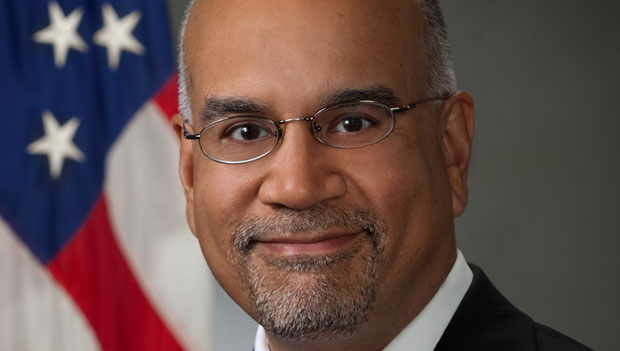Database integration clears new path for law enforcement information sharing
Kshemendra Paul, the program manager of the Information Sharing Environment, said a recently completed effort lets federal, state and local public safety entities...
Federal, state and local law enforcement officers no longer have to check multiple and disparate databases to ensure they aren’t stepping on each other’s toes.
The concept of event deconfliction is part of the federally-led effort to improve information sharing across law enforcement entities around the country.
Kshemendra Paul, the program manager of the Information Sharing Environment, said with one query, officers can receive information from three databases—RISSafe , Case Explorer and SAFETNet.

“Today, if you deconflict in one of those systems, you are deconflicting in all of them. That is a big step forward within the framework of the Information Sharing Environment,” Paul said in an interview with Federal News Radio. “So the big step forward here is the RISSafe folks, the high-intensity drug trafficking areas, which is about 20-to-24 across the country, and the national network of fusion center folks came together with federal partners, but it was mainly a state and local driven activity, to interconnect their systems. Now that was at the technical level. They used ISE frameworks like the National Information Exchange Model (NIEM), Project Interoperability, the common profile and some of the other tools to build what they call a Partner Data Interface (PDI).”
Paul said the ISE, the Drug Enforcement Administration and other federal law enforcement agencies brought the state and local agencies together to agree on data definitions and other policies such as security.
In 2014, the ISE said more than 350,000 events were entered into officer safety event deconfliction systems by more than 3,500 law enforcement agencies, and those numbers are expected to increase with these improvements.
Paul said the push for event deconfliction isn’t new, but it took a maturity over the last few years of the trust and frameworks to make this happen.
He said the Government Accountability Office issued a report in April 2013 where it found several challenges for systems to talk to each other and perform deconflictions.
GAO said at the time that the three systems didn’t talk and that created overlap and made information sharing more difficult.
But through the efforts of state and local law enforcement leaders, the effort to bring these disparate systems together took off.
Paul said then the ISE helped bring the initiative home by through the integration of the technical approaches and the Justice Department’s input.
“The beautiful thing about that happened here because of the distributed and decentralized architecture under the ISE, the operational processes in the individual agencies didn’t change,” he said. “Where they previously deconflicted in their stovepiped system, now when they deconflict, it’s a national deconfliction.”
Paul said the ISE or DoJ didn’t contribute a lot of money to this effort.
He said the reason it worked was the broad-based adoption of the ISE frameworks and Project Interoperability, the confidence of the governance and collaboration structures and the persistence over the years.
“This is really partner based. I need to come back to that. We supported our partners that wanted to use ISE frameworks at the policy level, the business process level and the technical level to improve their operations,” Paul said. “They all recognized looking at our public safety enterprise, there are opportunities for greater alignment, and on their own volition under the framework under the ISE, they pushed that forward.”
The benefits of this concept were immediately realized. Paul said during the acceptance testing of the PDI application, the law enforcement agencies found conflicts where Michigan agencies were doing some operations in California and they were able to ensure everyone was one the same page.
“Many times these conflicts are not hard conflicts. It’s more of a identifying the need to let folks know what’s going on and the courtesy of operating and pursuing investigation outside your area of responsibility or if you have overlapping jurisdictions,” he said.
Paul said the key to this effort was when the leaders came together, built confidence in a common approach and got comfortable with that approach.
Now that the event deconfliction initiative has hit full operational capability, Paul said there are several next steps.
He said the ISE will work with state and local law enforcement agencies to baseline performance metrics across all three systems so they can better manage the processes.
“There is a lot of energy with our federal, state, local and tribal law enforcement partners to move from the 3,500 law enforcement agencies to the more than 18,000 police departments in this country,” he said. “My state and local partners and federal partners look at this as really the standard of practice and we want to get this implement broadly.”
The concept of deconfliction also can be expanded to include case and/or subject areas.
“We have pockets of excellence around that. There are different agencies that do that, regions of the country and in some cases states that are doing a pretty good job of case/subject deconfliction,” he said. “We want to increase that and build on this momentum here that folks are doing deconfliction. This is the standard of practice, this is the right way. It’s a courtesy thing. It’s a collaboration thing. It’s a resource and efficiency thing It’s a criminal intelligence thing where you need to be able to share information about what’s going on.”
Copyright © 2025 Federal News Network. All rights reserved. This website is not intended for users located within the European Economic Area.
Jason Miller is executive editor of Federal News Network and directs news coverage on the people, policy and programs of the federal government.
Follow @jmillerWFED
Related Stories

For feds, secure information sharing puzzle slowly coming together




